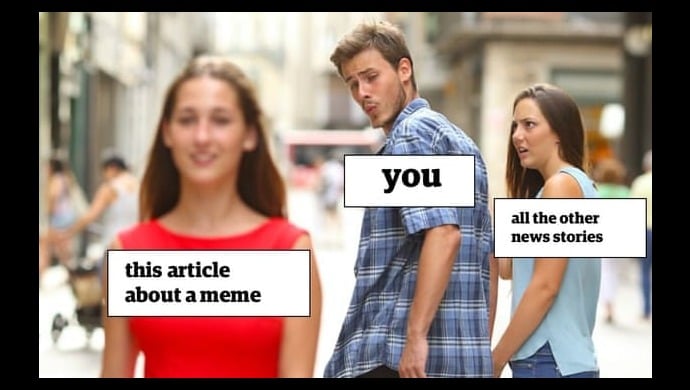How’s your sense of humour?

Remember the ice bucket challenge? Boy did that draw some attention – and rightfully so, given that the challenge was created for charity.
What about the #TheDress…or the planking phenomenon? Footage of Dawson’s Creek heartthrob James Van Der Beek sobbing and that photo of ‘duckface’ that went viral?
Or how about phrases like “bye Felicia”, “that’s what she said” and every ‘Keep Calm and Carry On’ poster or mug you’ve ever seen?
You may have simply regarded these as humorous but fleeting snippets of pop culture — however, these viral images were something else entirely.
They were memes.
By definition, a meme is a concept, behaviour or idea that spreads within a culture, usually via the internet.
Usually, memes manifest as a picture or video with text, but they can also be in the form of a hashtag, simple phrase, word or website.
A meme typically carries a deeper meaning or significance, and acts as a cultural icon or imitable phenomena, one which typically uses humour to do so. And, people absolutely love them.
What you likely didn’t know is that many of the popular memes you yourself may have chuckled at via social media or text messages were examples of smart digital marketing disguised as memes.
For example, ‘Success Kid’ – the photo of a little toddler with his fist scrunched up triumphantly, paired perfectly with a phrase and coupled with ‘Nailed it’, was used as part of a larger digital marketing strategy by Virgin Media.
When DreamWorks featured its Shrek-based character Puss in Boots as the Old Spice Guy in its 2011 trailer to promote the movie spinoff, Puss in Boots — that too was an effective example of using a meme to promote a product.
Also Read: AirAsia launches US-based VC fund, strategic partnership with 500 Startups
The internet meme culture is one that has launched a new and powerful era in digital marketing.
A meme’s ability to speak to any generation, to turn a dull product or event into a popular one, and to attract viral attention has led to its newfound popularity on the internet and amongst cultures.
Even statistics are fans of memes.
According to research by Mittal, the average millennial looks at 20-30 memes per day and compared to regular marketing graphics (which yields roughly five per cent engagement on Facebook and Instagram), memes have about 10 times more reach with 60 per cent organic engagement.
There is simply no better way to engage potential customers and boost exposure than through meme-based humour in the digital age.
In Asia specifically, there has been unprecedented growth in digital in the past 24 months, and this has paved the way perfectly for the takeover of internet memes in the region.
According to data, the digital sector in Southeast Asia was booming in January 2018, with 370 million Internet users found mostly across the ASEAN countries of Indonesia, Thailand, Singapore, Philippines and Vietnam – with most of them using mobile phones to do so.
In these countries, records show that between 70 to 90 per cent of the population now uses the Internet regularly, with many doubling as active social media users. And, by 2025, it is anticipated that the digital market of Southeast Asia will be valued at around US$197 billion.
Therefore, it’s no surprise that digital marketers have increasingly shifted their focus to Southeast Asia in recent years, with companies now developing more aggressive and effective digital marketing strategies – such as the use of memes — in order to gain the edge over competitors.
This is also due to Asian countries seeing a drastic growth in the e-commerce market thanks to rising average incomes, increased mobile adoption and better internet infrastructure. So much so that, according to Research & Markets, over 50 per cent of global online retail sales in 2018 came from the Asia-Pacific region.
This reality patently paves the way for a whole lot of dollars to be earned as the result of better digital marketing strategies.
Also Read: Anthill Ventures launches program for healthtech, mediatech, urbantech startups
Asian marketing agencies have at last clocked onto the fact that social media users would much rather share a hilarious meme than a blog post promoting an event or product – and are leveraging this knowledge.
Done correctly, meme marketing can be hugely successful if designed by native marketers specifically for social platforms and constructed with merely a casual reference to the brand.
Any trace of overly promotional content will be a massive turn off for the audience, leading to its ultimate failure.
What is crucially important is ensuring your company’s meme does not become offensive, accidentally, and that it is actually funny. Follow these simple golden rules and your brand could also soon be seriously reaping the rewards of the internet meme culture.
—
This meme is one of the many versions of the “distracted boyfriend” meme. Photograph by antonioguillem
e27 publishes relevant guest contributions from the community. Share your honest opinions and expert knowledge by submitting your content here.
The post Meme marketing isn’t a joke — it’s an A-1 strategy, especially in Asia appeared first on e27.
Source: E27

